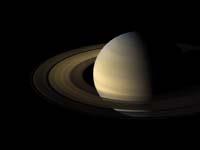Why does Saturn's B ring look like a vinyl record?

For three decades, Saturn's brightest and most massive ring has also been the most mysterious of all. Ring B has dark lines that look like a vinyl record. But scientists have not been able to determine how they occur. Now researchers at the Boulder Institute of Space Sciences (Colorado) have explained that the denser parts of the rings have a natural tendency to cluster into denser, brighter bands.
To reach this conclusion, astronomers have analyzed thousands of images that the Cassini probe has taken to ring B for four years. Three weak rhythmic pulsations have been identified in the outer edge position of the ring. These oscillations, at the same rate, move the edge inward and outward-about 75 kilometers.
According to researchers, this procedure can only occur in ring B, where particles are very close to each other, so they behave more like liquids than gas. The small random alterations bring them closer, giving rise to a kind of wave or wave of particles with the same frequencies observed at the edge of the ring. Soft collisions between the ring particles amplify the waves until they have sufficient force to appear as pulsations on the edge of ring B. Possibly, these waves that originate spontaneously are due to that aspect that is full of slits in the B ring of Saturn.
Astronomers believe that other similar oscillations can occur in other dust discs, spiral galaxies, or gas planets near stars. So far, however, its existence has not been confirmed.





